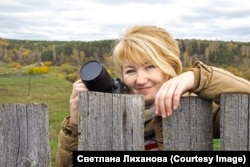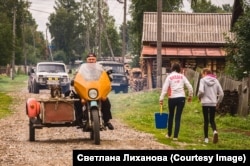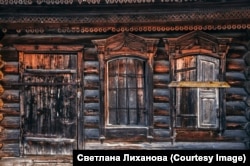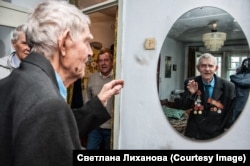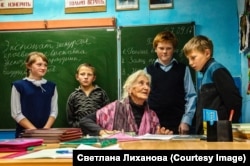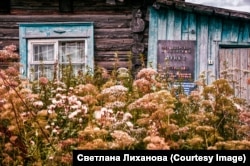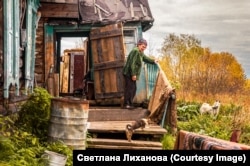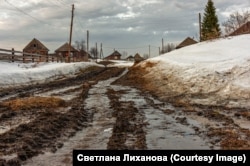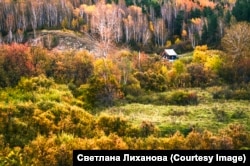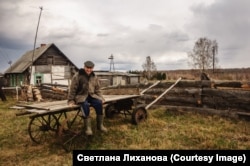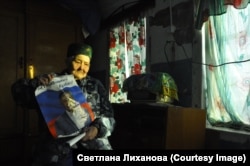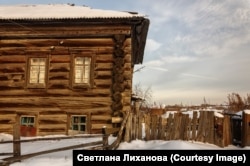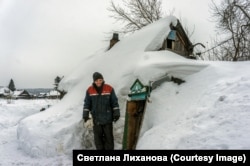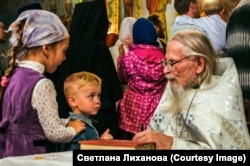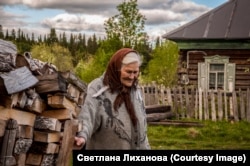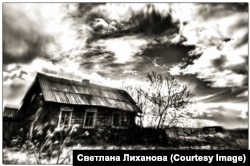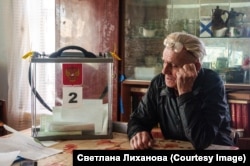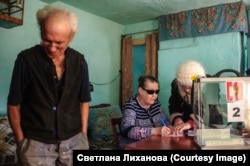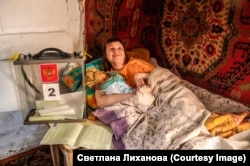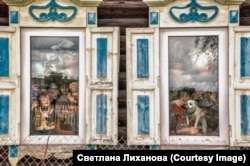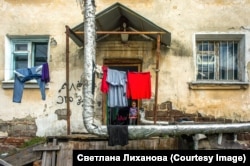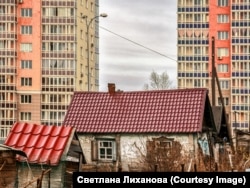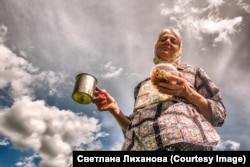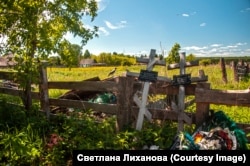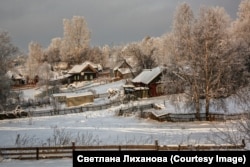Russia's Kuzbass region celebrates its 300th anniversary this year. A region in southwestern Siberia, the Kuzbass holds some of the largest coal reserves in the world. Despite the region's mineral wealth, life in the villages remains hard. A local photographer, Svetlana Likhanova, has devoted her life to documenting the daily lives and struggles of the people of the Kuzbass.
Svetlana Likhanova was born in Yurga, a town in the northwest of the Kuzbass. For the past seven years, she has not parted with her camera. The main focus of her photography is the disappearing Russian countryside -- specifically, the villages of the Kuzbass.
"I came into photography by chance," says Likhanova. "I worked at a train depot as a milling-machine operator and got laid off before New Year's Eve in 2014. After that, I had more free time.
"Relatives gave me a small Samsung camera as a present, with which I made my first deliberate photograph. I was washing fruit and the water drops scattered so beautifully. I wanted to take a picture. But to understand how to 'freeze' water droplets, you need to understand the camera settings. So I began to study and look for information on the Internet. I watched master classes at night, made notes. At the same time, I photographed and published a lot of photos on social networks. In the comments, some praised but someone criticized them. I wanted to prove that I could do better.
"Why do I photograph the villages? Because of my childhood. I remember the setting of a village house in which we lived with my parents when I was 3 to 5 years old -- in Pikhtach, [by] a small railway station between Taiga and Anzhero-Sudzhensk (cities in the Kuzbass). Then we moved to Taiga -- in fact, a very similar village, just a bigger one. A hut divided between four owners. On the one side, there was a railway with poplar trees; on the other, swamps and ponds.
"For whole days, we played in the countryside, swam, gathered wild strawberries. People in the village are sincere, more open than in the city. Therefore, the theme of the village is very close to my heart," Likhanova says.
"I'm very sad to realize that a true Russian village will disappear in a few decades. The houses are not built from wood anymore. The houses are built with siding and slate," she says.
"For a fisherman or a mushroom picker, the process is important, not the result. It’s the same for me. I had a desire to take pictures. I dropped everything, went outside, and wandered through the streets of Taiga in search of something interesting and took pictures."
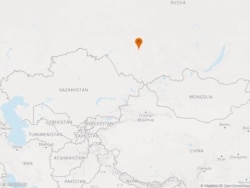
"I met Tatiana, a photographer from Anzherka. We began to travel to the villages together. We would just come to the train station, look at the map for a village we hadn’t yet been to, and take off! It all happened spontaneously."
Likhanova developed her hobby rapidly. She was admitted to the Union of Photo Artists of Russia, entered the Kemerovo Institute Of Culture, and became a finalist in the Best Of Russia photo competition with a photo from a series about Russia's veterans. She then worked at the newspaper Taiginsky Rabochiy and went on assignment with a group of social workers sent to congratulate World War II veterans.
"Almost all of them cried when they met us. I don’t know if those were tears of joy or they cried because they are only remembered on holidays," Likhanova says.
"Of course, not all of the photographs went to the newspaper then, but I was allowed to make an exhibition for May 9 (Victory Day in Russia). First in Taiga, and a year later in Kemerovo.
"Most of all, I was struck by an elderly woman from the village of Kuzel," Likhanova recalls. "She grabbed the donated 5,000 rubles (now approximately $70) so eagerly, began to count the money, and hid it immediately. I wanted to cry. Even though she lived with her son and daughter-in-law, the house was in such a mess that it would be better if she was assigned to a social shelter.
"And in 2017, my photo from a series about a school in the village of Suranovo was included in the list of the Best Of Russia winners," the photographer says.
"This photo show a teacher of Russian language and literature, Zinaida Evstigneevna. She was born in Suranovo.... She was a teacher at a local school all her life. And she still works there, even though she is already over 80. 'I will die at school,' she says.
"From Suranovo to Taiga, it's 30 kilometers by train. There was essentially no car connection with Taiga until four years ago. They've been promising to build the road for 40 years, but the Kemerovo region is in no hurry to fulfill the promises.
"How do people live in Suranovo? There is a small railway station where a couple of people work. A few people commute to work in Taiga. The rest have a pension. And they live in the forest, gather mushrooms. Mostly, people are trying to get out, leave the village. But there are exceptions. I met a young woman there, a mother with many children. Locals said that she moved there from Tomsk, without a husband. She bought a dilapidated house with her maternity money. They live on child support from the state.
"But most of all, I was struck by how they are buried in Suranovo. The deceased were loaded onto a train and taken to Anzhero-Sudzhensk for an autopsy and then back by train to the village.... In winter, the road to the cemetery was cleared of snow with shovels and the deceased were taken on a sled to be buried," Likhanova says.
"This is a photo of an overgrown feldsher and pharmacy building in Suranov," says Likhanova. A feldsher is a medical practitioner who is not fully qualified and has a different status than a doctor.
"Eleven kilometers from Taiga, there is another village -- Kuzel. A new feldsher and pharmacy building opened a few years ago but since then it has been closed. There is no one to work there. Paramedics come only occasionally, when it is necessary to administer vaccinations in large numbers. I wrote a post on Facebook asking my friends and subscribers how we could solve this problem. I came to the conclusion that the only way out is a global resettlement program from small villages to larger settlements.
"There are a lot of small settlements in the Kemerovo region. As long as there were state farms there, there was stability. People lived normally. The state farm provided jobs and housing. And now all the enterprises in the villages have collapsed, but people have remained. There are no schools there today. Nothing. How to survive? Only through a resettlement program."
"There are fewer than 100 people left in the village of Suranovo now. There are 10 students left in the school. The last child in the village will go to first grade next year; there are no more preschool children in Suranovo.
"Recently, there was the 300th anniversary of the Kuzbass region. All these celebrations are not for the villagers because they are, by and large, the unloved children of the Kuzbass," Likhanova says.
"The only thing that is good in our villages is ecology. But the roads are bad. All villages, except those on the federal highway, are difficult to reach. Many villages can only be reached by dirt roads, which are washed away in fall and spring; in winter, they are never cleaned of snow.
"Recently, we were in the village of Sergeevka near Anzhero-Sudzhensky and we could not get any Internet anywhere. A local girl showed us just one spot under the lighting pole where you could catch an Internet signal. People put up satellite dishes, but no one guarantees them a normal signal. But fast Internet is necessary for schoolchildren if we want them to grow up to be comprehensively developed personalities," she says.
"Villages near large cities look better because of the summerhouse residents. They transform and look more like elite cottage settlements. In a real village, people live for generations; the old houses are inherited. The spirit is very special there.
"In true villages, the mentality is different. All the people that are in my photographs are casual acquaintances. When I walk down the street with a camera, people get interested and a conversation starts.
"People often invite me over for tea," Likhanova says. "In the village of Yurty-Konstantinovy, which the common people call the Tatary, because it is a Tatar settlement, we went to visit an elderly lady, Abau. She has a two-story merchant house -- a real mansion. However, it is in bad condition. She lives in one room on the first floor.
"An old chest of drawers, a stove, and a tent over the bed, in which she sleeps. Probably it's not easy to heat the place, but it's warmer in the tent. My first thought was that she has no money at all, but she said otherwise. Her pension is almost 22,000 rubles (almost $300) per month. She lives alone. It was inconsiderate to ask what she spends her money on.
"Her valuables consist of a photo album, a small radio set, and a poster with a portrait of Aman Tuleyev [the previous governor of the Kuzbass, who was the head of the region for 20 years]. And an inflatable boat.... The neighbors said that some Tomsk residents came here, said that the house was an architectural monument, and offered her a lot of money and a move to Tomsk. But she refused. Her values are different and nonmaterialistic.
"There are many reclusive people here. In winter, we were in Butovka. It’s a former mining village, which is now on the outskirts of Kemerovo. We saw a dugout home. Only one window and door are sticking out from under the snow. And a grimy guy comes out of this dugout home. We started talking. He worked as a geodesist in the past. A lonely person, no family.
"We thought he was an asocial type, maybe alcoholic, but he said he doesn't drink or smoke at all. His pension is minimal: 13,000 rubles ($175) per month. When we asked if he was bored, he said: 'Why should I be bored? I love dogs. I have five of them. I plant two or three buckets of potatoes, dig out 10. I buy cereals. I have enough [food] for me and the dogs.'
"I asked him, hypothetically, if the state provided him an apartment, would he move?" Likhanova says. "'Why? I feel good here, too,' he answered.
"Almost every village house has a shelf with an icon. In cities, many remember their faith only on Easter or Trinity Sunday. But in the countryside, the faith is different -- simple and constant," Likhanova says.
"I myself rarely go to church, but I was struck by the religious service in the village of Kornilovo near Tomsk, where the priest does not read, but sings. Even nonbelievers are impressed by this.
"I also remember well a destroyed church in the village of Ishim. There was a similar one in the days of my childhood in Taiga. As a child, I was amazed that a birch sprouted through the ruins of the roof."
Likhanova says she does not make money from her photography.
"I just cannot," she says. "It is not possible to cooperate with editorial offices because I cannot work on assignment. For the same reason, I do not do commercial photography. I tried to shoot weddings, graduations, and realized that I was not interested.
"I don't like preparing for a long time to shoot something. In this regard, I admire the still-life painters because most of their time is spent on preparation. For me, photography is still an impression that lasts only a fraction of a second. And the main thing here is not to miss that very decisive moment.
"I do not like to shoot in one technique for a long time. I like to experiment. My final project at the Kemerovo Institute of Culture, from where I graduated in 2020, is in the style of pictorialism," Likhanova says. "For several years, I photographed the Kuzbass villages through distorted glass.
"As a photographer in Taiga, it was interesting for me to observe the work of election commissions. In the field, when you go directly to the houses, you understand how the Russian voter lives. I will tell you: They live poorly. It should be noted, of course, that the commission comes with a ballot box directly to the homes of the socially vulnerable -- the elderly and the disabled. Fair elections? I doubt it.
"In one house, I saw a 35-year-old mentally incapacitated woman. She was lying on the bed with a baby doll in her arms and did not understand who came to her and why. Her mother did not just point her finger at where to vote but literally made a mark on the ballot herself.
"The topic of the government is complex," Likhanova says. "As a photographer, I documented the election campaign for the mayor of Taiga. After a 10-year mayorship...he completely refused to run for the post again, but people persuaded him to do so.
"There were various attempts to expel observers from the polling stations. At a nearby polling station, observers recorded how the chairman of the commission stuffed ballots for his competitor. The police were called, they opened a case, and the next day the prosecutor's office annulled the election results at this polling station. But, nevertheless, the elected people's mayor was removed three months later.
"For a contest called Family Is The Soul Of Russia, I submitted a series that I did for the Taiginsky Rabochiy newspaper in 2017. It is about a large family that could not get housing, entitled by law, for a long time. After the publication, they thanked me, as the article and photographs contributed to a solution of the problem. The family immediately received financial assistance and an electric boiler. And a little later, money was allocated for the construction of a house. Last year, I visited Taiga and saw their new house," Likhanova says.
"Some photographers claim that they do not really need a viewer. But I desperately need feedback. I think that the most successful of my series is about Andrei, an orphan from Taiga with progressive multiple sclerosis.
"After reaching adolescence, he ended up living in a delapidated communal room without a toilet, with stripped floors and open wiring. At that time, Andrei was already moving with the help of a walker. Relatives and the social worker had little interest in his destiny. As a disabled child left without parental care, he was supposed to get municipal housing, but his turn was not even coming close. From ninth place in a queue, he was moved back to 11th in a year.
"I came to visit him, photographed how he lives, and posted it on social networks. We made a fuss. The social workers came to their senses. They made repairs, put in a new toilet.... But we did not stop there. Six months later, he got the apartment he was entitled to by law. He got housing in a new building and even got married. They often call me and everything is fine with them.
"This poorly maintained house is where we lived in Taiga from 2000 to 2005. My daughter Daria was born there. When I took this photo last year," Likhanova says, "I thought with horror: 'What would my child have become if she spent all her childhood in such conditions?'
"In the center of the picture is a girl with a stroller, which means that they still live in the house. And I honestly do not envy them. By some miracle, we managed to sell it back then and moved to private housing. But in the end, we left Taiga for Kemerovo.
"When you live in a town for 40 years, walk down the same street to work and see how every year your native and once beloved town is slowly dying, it is depressing. For a long time, there was no buyer for the house. There was a moment when I was ready to just leave it out of despair.
"In Kemerovo, I like to shoot on the outskirts more. I often see destroyed wooden houses against the background of new buildings in different districts of Kemerovo. The contrast is striking.
"Sometimes the construction of new housing is under way, but one wooden house remains because the owner does not want to leave. The city is occupying the village.
"When I was a child, we had an elderly neighbor, Zina, and we bought milk from her. She lived alone, worked in the garden, kept a cow, calves, piglets, although she was already over 70. And then the construction of the railway viaduct began. Our houses were demolished, and she was moved to an apartment. She did not live there long; she died in less than a year. Why? Because of yearning.
"At the Kemerovo cemetery, for the first time in my life, I saw the burial of the homeless -- a vivid confirmation of the frailty of life. They dig trenches and put them there. They put up a simple wooden cross with an iron sign, on which in a few years nothing can be read. Such sadness. A person lives and then there is no one to bury them," Likhanova says.
"I began to visit the graveyards in the villages. I was not looking for specific people, but for something poetic -- unusual monuments, ancient textures, interesting images.
"This photo was taken in the village of Ishim. Two crosses have been dug up and thrown aside. A bird sits nearby and in the distance a dilapidated house, which is also dying, is slowly disappearing from the face of the Earth. It is symbolic."





